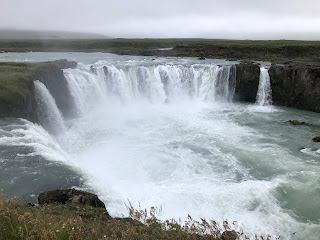North Iceland
The transition to North Iceland is at (more or less) Borðeyri where we camped. The following day we headed to Hvammistangi where we wanted to visit the Iceland Seal Centre. This visit ended up in our participation in the annual seal count, which was a very enjoyable opportunity to walk the coastline in our designated count area. We returned to the Centre to submit our seal count form, finding that we were the first back (principally owing to our having misunderstood the start time, however the officials were happy with the result).
From here we made our way into the Highlands for the first time, via F35 (for which 4x4 is required), and reached Hveravellir Lodge in high winds and rain. Camping was out of the question however we were able to rent a cubicle in the Hut (shipping Container 4) and after setting up in this tiny space went to the geysers to enjoy the hot springs.
Our next port of call was the excellent Icelandic Textile Centre at Blönduós, after which we headed for Akureyri, stopping for lunch at the surprising Ethiopian restaurant, where we ate well with with Jimi Hendrix on the sound system. We enjoyed Hófsos pool before continued around the coast to Akureyri.
Akureyri is Iceland’s second city and offers a wide range of attractions; we visited the Botanical Garden, where we focussed on the Arctic and Sub-Arctic sections, the Akureyri Art Museum, the Motorcycle museum, with a surprisingly extensive range of bikes, and did some shopping for the next few days of camping.
We then made our way eastwards, via Systragil, with a pleasant campground set in a forest site, and then embarked on a more intensive trail of waterfalls than hitherto: Aldeyarfoss, Hrafnabjargafoss, and Godafoss, and Ædarfossar, among others, prior to reaching Húsavik.
Ásbyrgi Canyon is a fascinating point at which the floor of the canyon is created by geological slumping, or if you prefer – by the footstep of Sleipnir, Odin’s steed. Among other attractions we explored more waterfalls – Hafragilsfoss, Dettifoss, and Selfoss prior to reaching the Myvatn Lake area, camping at Hlíð Campsite which became our base for exploration of Krafla, Leirhnjúkur, the Myvatn power information centre, then Hverir where we walked up to the peak (and back). We visited the littoral craters (“pseudo-craters”) at Skútustaðir, Dimmuborgir lava field, Hverfjall, and later to Myvatn Springs.
On our way back to the coast we stopped at Dettifoss again, on the east bank, walking both Dettifoss and Selfoss then driving to Hafragilsfoss. We then travelled into the northernmost area of Iceland, part of which lies north of 66.5 degrees latitude, so could arguably be described as being in the Arctic, although the actual Arctic Circle latitude varies and at this time the only part of Iceland in the Arctic is Grimsey Island. We visited Nyhöfn, walked to Rauðinúpur Cape (and back), and stopped briefly 1 km south of Hraunhafnartangi lighthouse so 3 km north of 66.5 degrees north. Arctic Henge is an interesting modern monument, worth a stop.
We camped inside Tjaldsvæði Raufarhafnar Campsite, Raufarhöfn. The site is protected by an earth wall, presumably to provide shelter from the wind. From here we went to Rauðanes, visiting “bridge rock”, and then continued to Þórshöfn, then to Gljúfursárfoss. From here we headed into the East Fjords.
Alan & Marce, 2021 July/August













No comments:
Post a Comment